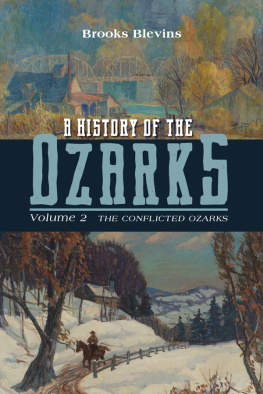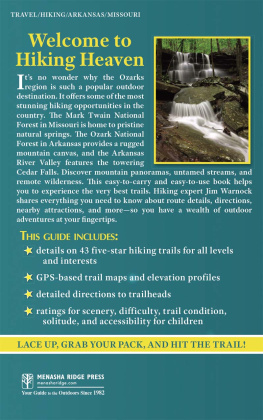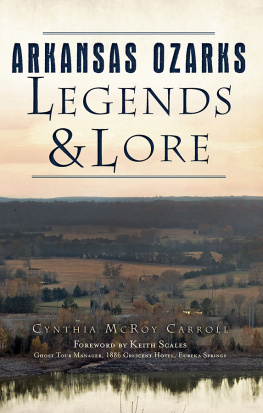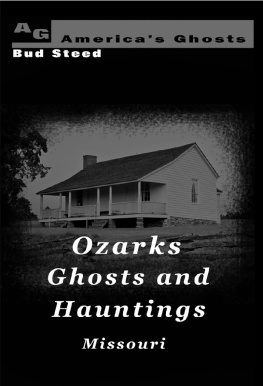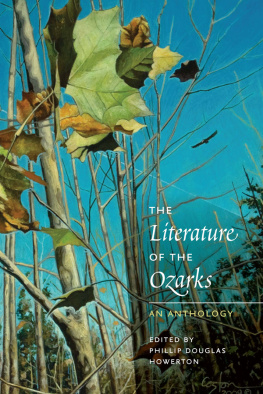Acknowledgments
So many people contributed to the making of this book that I'm bound to omit a few deserving names, but I'll do my best. Much of the research was made possible by a grant from the Graduate College of Missouri State University (MSU), and I thank Dean Victor Matthews and the MSU College of Humanities and Public Affairs for the yearlong sabbatical during which much of the first draft was completed.
I received valuable assistance at a number of research depositories. I thank Anne M. Baker, Tracie Gieselman-Holthaus, and Shannon Mawhiney of the Missouri State University Special Collections. Geoffrey Stark, Joshua Youngblood, and the staff at the University of Arkansas Special Collections in Fayetteville were always helpful, friendly, and professional. As always, I benefited immeasurably from the aid of the staff at the Shiloh Museum of Ozark History in Springdale, Arkansas, including Allyn Lord, Carolyn Reno, Marie Demeroukas, and Susan Young. Meredith McFadden at the Northeast Arkansas Regional Archives in Powhatan provided generous help and advice. I appreciate the help and hospitality of John Bradbury, Katie Seale, and Carole Goggin at the Rolla research center of the State Historical Society of Missouri. I benefited from the cheerful aid of Erin Smither and Jami Lewis at the State Historical Society's Springfield center and of Connie Yen at the Greene County Archives. I appreciate the help of Gary Kremer, Anne Cox, and the staff at the State Historical Society in Columbia, as well as the staffs at Cape Girardeau and St. Louis. Michael Price, Brian Grubbs, and Renee Glass of the Library Center in Springfield, Missouri, provided crucial information and assistance, as did Jeff Patrick at the Hulston Library of Wilson's Creek National Battlefield.
Sylvia Kuhlmeier, Sophia Skinner, and Neva Parrott are always friendly and helpful on my frequent visits to the Garnett Library at MSUWest Plains, as are my longtime friends at Lyon College's Mabee-Simpson Library: Kathy Whittenton, Camille Beary, Brenda Lindsey, and Rob Austin. I thank the professionals at the Missouri Historical Museum and Archives in St. Louis, the Missouri State Archives in Jefferson City, Brian Irby and other staff members at the Arkansas State Archives in Little Rock, Brenda Bradford of the John Vaughan Library at Northeastern State University, Teresa Coble of the Kansas State Historical Society, the Butler Center for Arkansas Studies in Little Rock, the Murray State University Special Collections and Archives, the Rubenstein Library at Duke University, the Southern Historical Collection in the Wilson Library at the University of North Carolina at Chapel Hill, and the Tennessee State Library and Archives in Nashville. I also appreciate the assistance and support of Tom Peters, Shannon Conlon, and the staff at the Meyer Library of Missouri State University, Dan Lindsey at the Paul Weaver Library at Ozarka College, Lynn Maples at the Current River Heritage Museum in Doniphan, Missouri, and Maximino Diaz at the Melbourne Public Library in Arkansas. I have benefited from the help of other librarians at public libraries across the region, including Missouri institutions in Aurora, Vienna, Neosho, West Plains, Lebanon, Alton, Doniphan, Joplin, Gainesville, and Piedmont and Arkansas libraries in Mountain Home, Marshall, Salem, Viola, Green Forest, Berryville, Jasper, Calico Rock, Mountain View, Yellville, and Fayetteville.
For the many hours they spent crafting the maps that appear in the book, I thank Jim Coombs and Emilie Burke. For their efforts in compiling statistical data, I thank Zachary Beck and Jordan Webb. For a variety of reasons I am indebted to Cindy Poole, Laura Sipes, Carolyn Gillihan, Catherine Grills, Barbara Cecil, Jay Jenkins, Annie Blevins, Bryan Blevins, Sharon Blevins, Chris Cochran, Brien Hall, and Amy Love's phone. Among the many others whose contributions deserve note are Kim Harper, George Lankford, Vincent Anderson, Martha Pettegrew, Ben Rader, Gordon McCann, James J. Johnston, Donald Holliday, Jeremy Neely, and Hannah Wood. A number of scholars read all or parts of this book in manuscript form, including Patrick Williams and two anonymous readers for the Arkansas Historical Quarterly. The book and the trilogy are stronger because of the advice of Dan Pierce and Blake Perkins. Lynn Morrow and John Bradbury lent their expertise in careful readings, saving me from a number of errors. Any that remain are of my doing alone. Once again, it has been a pleasure and an honor to work with the wonderful staff at the University of Illinois Press. James Engelhardt championed the idea of a trilogy on the Ozarks almost from the beginning of our correspondence, and he has proven to be a first-rate editor by any measurement. Tad Ringo served as an expert project manager, and Jill R. Hughes once again proved an expert copyeditor.
Far too belatedly, I dedicate this book to my mentor Wayne Flynt. It's going on three decades now since Elizabeth Jacoway first introduced Wayne to one of her undergraduate students via a very rough research paper written for a course on the civil rights movement. That token of scholarly magnanimity led me into the orbit of a man who will forever be my model of the scholar/teacher. Few historians have devoted as much time and energy to the ongoing quest to understand the South, and I know of no other scholar who possesses Wayne's talent and desire for sharing that understanding with people outside the halls of academe. He taught generations of students at Samford and Auburn how to be conscientious historians and accessible writers, but, most importantly, Wayne Flynt showed us by example how to be better humans. I hope this book in some way merits the countless hours Wayne spent reading and critiquing drafts of my thesis, dissertation, and books and the years of unflagging support he has granted me.
BROOKS BLEVINS is the Noel Boyd Professor of Ozarks Studies at Missouri State University. He is the author or editor of nine books, including A History of the Ozarks, Volume 1: The Old Ozarks; Ghost of the Ozarks: Murder and Memory in the Upland South; and Arkansas/Arkansaw: How Bear Hunters, Hillbillies, and Good Ol Boys Defined a State.
The University of Illinois Press
is a founding member of the
Association of University Presses.
_______________________
University of Illinois Press
1325 South Oak Street
Champaign, IL 61820-6903
www.press.uillinois.edu
1 A REGION ON THE DIVIDE
For anyone steeped in the popular culture of mid-twentieth-century American animation but unfamiliar with the fauna of the Ozarks, the sight of a roadrunner darting across the road in the hills of Arkansas or Missouri must be perplexing. The sleek bird may be more commonly associated with the desert Southwest, but it is just as at home in the Ozark uplift, its easternmost habitat. And it is especially common in rugged, usually infertile areas of the region featuring an abundance of tiny ecosystems based around xeric rock outcroppings on south- and west-facing ridges and hills. Known as glades, these outcroppings and the roadrunners and other species they support represent the geographic amorphousness of the Ozark uplift. As the continent's middle highlands, the Ozark uplift forms a sort of bridge between the East and West. The physical region is in many ways only slightly distinguishable from the Appalachian upcountry, but the Ozark glades, when not smothered by cedars in the post-landscape-burning era, function as little transitional desert ecosystems, with plants and animals found almost nowhere else in the region, sometimes almost nowhere else on the continentprickly pears; purple and yellow coneflowers; primroses; black-eyed Susans; tarantulas; scorpions; painted buntings; large, colorful collard lizards known colloquially as boomers; and, of course, roadrunners.
Next page
